As more and more employers realize the importance of improving employee engagement in their company, the demand for effective employee engagement programs is on the rise.
And we’re glad to tell you that, in this article, we go over seven of them.
We realize the Internet is full of employee engagement initiatives, but ours come with an extra something: case studies to show you that the employee engagement strategies we picked are truly effective.
So, read on if you want to see more employee satisfaction, receive positive employee feedback, and of course, ensure that your office is buzzing with high employee engagement.
What Is Employee Engagement?
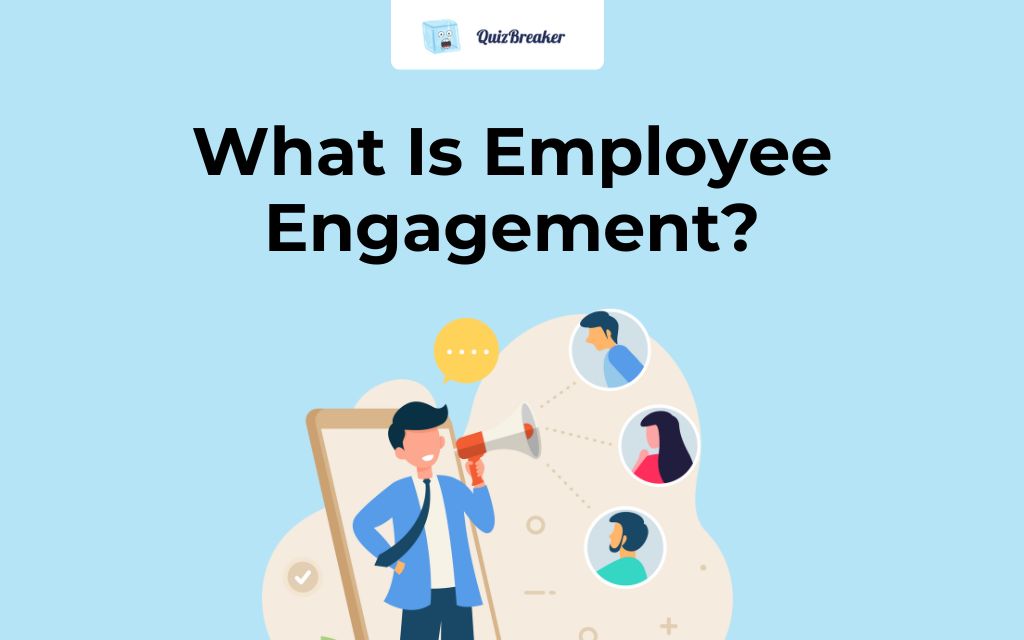
If you’ve been scrolling through our blog, you might have noticed we write a lot about employee engagement. In fact, our platform is built to support this amazing employee experience and help employers boost engagement in their organization.
It feels like the more we write about engagement, the more there’s to be said. After all, employee engagement is such a versatile topic, that there’s always something new to be added. For instance, in (almost) every article we (try to) define employee engagement and provide several useful definitions for readers such as yourself, but we always have a new definition or a fresh explanation about the matter.
And this article is no exception.
In fact, this time we decided to include employee engagement definitions provided by very well-known companies such as Vodafone, Johnson and Johnson, and Nokia Siemens.
Johnson and Johnson offer the following definition:
”the degree to which employees are satisfied with their jobs, feel valued, and experience collaboration and trust. Engaged employees will stay with the company longer and continually find smarter, more effective ways to add value to the organisation. The end result is a high performing company where people are flourishing and productivity is increased and sustained.”
Vodafone defines engagement as “an outcome measured or seen as a result of people being committed to something or someone in the business – a very best effort that is willingly given”.
And finally, Nokia Siemens Networks describes the act of being engaged as “an emotional attachment to the organisation, pride and a willingness to be an advocate of the organisation, a rational understanding of the organisationʹs strategic goals, the company's values, and how employees fit and motivation and willingness to invest discretionary effort to go above and beyond”.
Overall, these company definitions perceive employee engagement as an outcome and usually something the employee “gives” to the organization they work for. It’s mostly about the effort, strategies, and commitment they show in front of their superiors. Johnson and Johnson’s definition, however, tends to stress the importance of the reciprocal relationship between the employer and the employee. It also talks about collaboration, the overall atmosphere in the workplace, and feeling valued.
And while learning what employee engagement means and why it’s important is a great first step, employers also need to incorporate practical employee recognition programs as part of their company culture. This is what the next sections are all about.
7 Best Employee Engagement Programs
There are many employee engagement programs out there, but not all of them are worth your time. You want programs that put your workers in the center and allow them to truly feel a sense of completion, purpose, and belonging. This is why we included only the most effective best practices for employee engagement programs that make a difference, so let’s start with the first one.
1. Show Appreciation

The first, and dare we say most important step towards boosting engagement in a company is letting your employees know that they’re valued and appreciated.
Each worker wants to be validated, acknowledged, and appreciated. This helps employees to remain motivated, be more engaged, stay productive and on track with their tasks, and perform better.
There are many ways to do this and it all depends on your approach as an employer and what your workers resonate with. For instance, you may enjoy giving public recognition for good work, but if there’s a shy employee in your office they may not feel so comfortable with being recognized in such a manner.
This is why it’s good to have several great ideas you can rotate in the office. And over time you get to learn which ones are widely accepted and which recognition ideas aren’t as embraced.
If you need more new ideas, take a look at our list of the best virtual team building activities article to learn more. Here are just some of the suggestions to reward great work:
-
providing a VIP parking treatment;
-
introducing a “CEO for the day program”;
-
sending (e)cards;
-
giving an employee recognition speech;
-
celebrating employee appreciation day;
-
gifting a care package;
-
providing surprise food treats;
-
providing professional development opportunities;
-
introducing a peer recognition program, and so on.
Case Study
If you need further reassurance of the importance of showing appreciation and recognition, we invite you to consider the following study which analyzes the impact of sending social workers personalized letters of recognition to their home addresses. Half of all social workers were randomly selected to receive letters from their business leaders, whereas the other half didn’t get any letters.
The letters were structured in the following manner: they had two sentences of positive feedback. The first sentence was chosen from a menu of several options, such as “your work has consistently had a positive impact on the children you work with” or “your continued dedication and hard work make children and families in the region better off every day”. The second sentence, however, was written by the managers. This was done so that the letters were more or less standardized, but at the same time personalized as well.
The study showed that a month after this “letter experiment”, the social workers who received the letters said they felt much more appreciated, valued, and recognized for their efforts, as opposed to those who didn’t receive any letters.
Apart from these findings, there was also a positive impact on the workers’ wellbeing, intrinsic motivation levels, sense of belonging, to name a few.
Finally, you don’t need to send letters and copy the study in the exact same manner - starting with something as little as a short note where you express gratitude to an employee is more than enough. It’ll take you very little time to do it, but it’ll mean a lot to your employees.
2. Focus on Employee Wellness
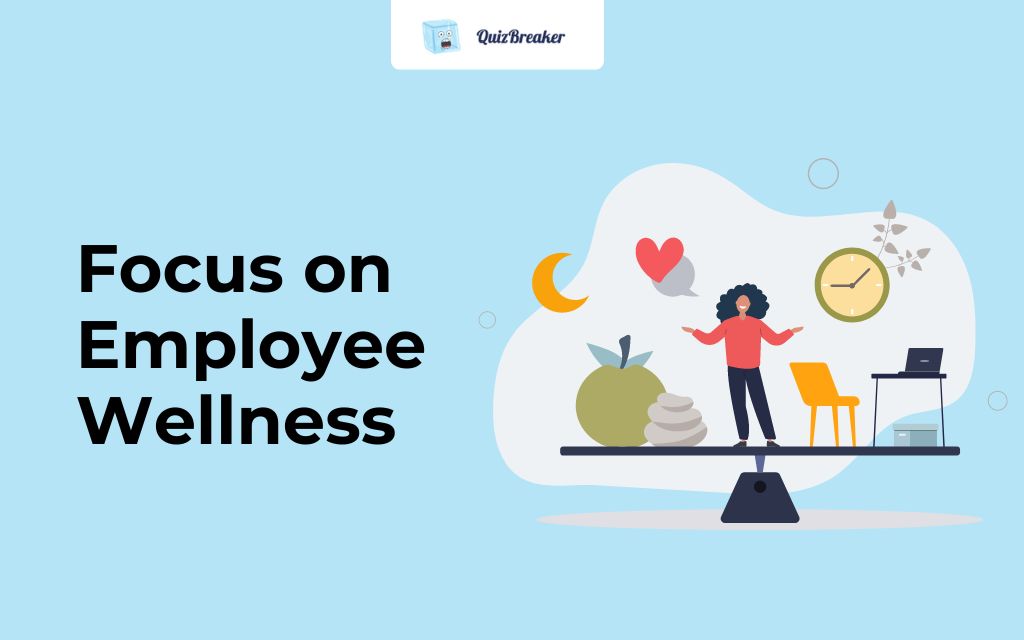
To understand what makes employee wellness so important, we need to comprehend its definition first. Namely, employee wellness has been defined as:
”a set of organized activities and systematic interventions, offered through corporations/worksites, managed care organizations, and governmental/community agencies, whose primary purposes are to provide health education, identify modifiable health risks, and influence health behavior changes.”
Employee wellness has many components, some of the most important ones being mental health, nutrition, healthy work/life balance, fitness, stress management, to name a few, and introducing such a program in your company is useful for both the employees and employers.
Namely, being in good health should be everyone’s priority, and providing this opportunity to your employees will make them feel valued and cared for. Feeling better both physically and mentally will, in turn, boost their morale, motivation, and productivity, so it’s a win-win for everyone in the company.
If you decide to come up with a wellness program, the possibilities as to what you can include are limitless. For instance, if you wish to help your workers with stress management, you can organize yoga classes in the office (alternatively, you may give them vouchers for a yoga studio). In case you’re concerned about their mental health, you can provide them with five health days per year (in addition to their regular sickness and vacation days).
Another great idea would be to ensure there’s always fresh and organic fruit in the office along with other healthy snacks. You can leave some nutrition flyers, too. This last idea brings us to the next section in the article which is about the benefits of having a wellness room in your company.
A Wellness Room
Not all companies have a wellness room, but those that do probably never think about getting rid of it. Why is that so?
The whole idea behind a wellness room is to provide employees with a private area where they can look after their personal needs. For example, if an employee has a headache or is feeling slightly under the weather, they might take a bit of time to recover there. Workers who take regular medication, yet feel uncomfortable taking their therapy (whether in a pill or in an injection form) in front of others, may find it easier to do so in a wellness room.
Keep in mind that you don’t need to break the bank to create a welcoming wellness room. It’s all about the atmosphere in the room and finding the right space. Additionally, make sure there’s comfortable seating (you may pick a larger sofa), a small fridge with some healthy drinks and snacks, low lighting, and perhaps even a few blankets.
Ultimately, having a wellness room in your company is a choice you need to make. And if this isn’t something that resonates with your or your company’s approach, by all means, opt for another wellness option. As we said, it’s all about ensuring workers’ overall well-being needs are met. Fortunately, that can be achieved in many ways.
Case Study
You won’t be able to come up with an effective wellness strategy for your organization if you don’t understand the role wellness has in your office. We’re hoping the study below will be enough to get you started.
This study seeks to answer the following questions:
-
What are the characteristics and prevalence of current workplace wellness programs?
-
What is the evidence for program impact?
-
What is the role of incentives under wellness programs?
-
What are the key facilitators of successful wellness programs?
The purpose of this research is to explore the characteristics of workplace wellness programs, their impact on the overall employee health, medical costs, their prevalence, and so on.
And these are some of the most important factors the study identified when it comes to promoting wellness programs in a corporate context:
-
Valuable communication strategies. All organizations that took part in this research stress the importance of communicating wellness program information to workers (this includes both in-person and mass dissemination strategies). Also, clear interaction and messaging are especially relevant for companies with a geographically dispersed team.
-
Opportunities for workers to show engagement. Those who took part in the study discussions stated that making wellness programs accessible for all workers is an efficient strategy for boosting the employee engagement levels in their organizations.
-
Leadership engaged across all company levels. The study results suggest that in order for these wellness programs to be a success, senior company leaders ought to treat wellness as a priority in the company culture.
-
Use of already existing resources and connections. All organizations are said to leverage existing resources and tend to build relationships (quite often including health plans) in order to expand the options they provide their workers with.
-
Continuous assessment. There’s an overall agreement among all companies that ongoing assessments are needed so that employers can better understand the wellness needs of their workers.
3. Have Development-focused Employee Engagement Initiatives
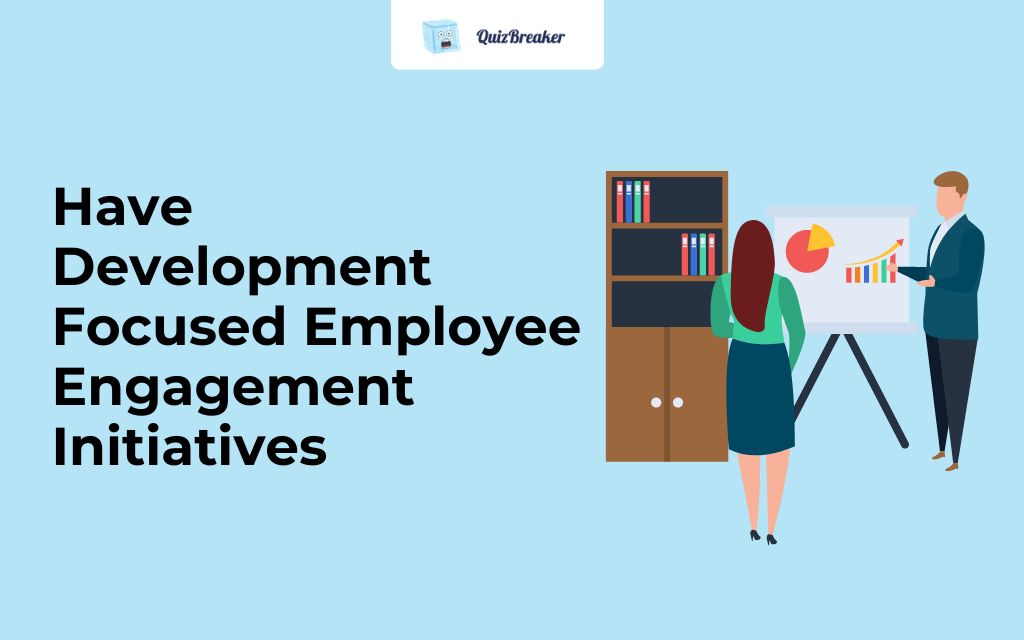
Ongoing development is important for every worker and every industry out there. Yet, not a lot of employees seem to know how to work on improving their skills, and not many employers are willing to create opportunities for them to do so.
Below, we share a list of some common development-focused initiatives which can assist your employees in their professional growth:
-
networking events;
-
professional networking groups/organizations;
-
master's degree programs (or perhaps even Ph.D. - it all depends on the employees’ current education level);
-
industry training courses;
-
industry conferences;
-
webinars or seminars;
-
mentoring programs;
-
internal promotions;
-
career coaching (yes, career coaching can be a great tool, even for employees who already have a job);
-
skill advancement certifications, and so on.
On the whole, such employee engagement programs can introduce your employees to some new areas of professional interest, inspire them to be more motivated, as well as provide them with a sense of fulfillment.
Case Study
For this part, we chose a study called A Study on the Influence of Career Growth on Work Engagement among New Generation Employees.
We consider career growth to be an important part of each worker’s professional life, so we truly believe this study will be of interest. After all, career pathways not only prepare employees for the next level of their employment, but also help workers influence regional economics and build much stronger and lasting relationships with their employers.
This study suggests that employee career growth has a tremendous impact on concepts such as
-
work performance;
-
engagement;
-
organizational commitment;
-
employee turnover, and others.
On the whole, this case study was devoted to carrying out detailed research by taking into account the following two aspects:
-
explaining the relationships between career growth and engagement among newer generations of workers;
-
exploring the influence career growth has on engagement [to do so, the study includes a so-called organizational identification (OI), a term used to denote how inclined an individual is toward the company/organization they belong to]. You can read more about this in the study we linked above, we’re just explaining it here briefly so that you’re able to make sense of the study findings below.
What’s more, there are five research hypotheses included:
-
H1: Employee career growth has a positive impact on work engagement.
-
H2: The career growth of employees has a positive impact on organizational identification.
-
H3: Organizational identification has a positive impact on employee’s work engagement.
-
H4: Organizational identification has mediating effect between career growth and work engagement.
-
H5: Person-organization value fit plays a positive regulatory role in the impact of career growth on organizational identification.
On the whole, the study includes six companies from a wide range of industries, such as real estate, management, consulting, finances, and so on.
The study results show that:
-
Employee career growth has a positive effect on work engagement;
-
Organizational identification (IO) has an important role between engagement levels and career growth;
-
Person-organization value has a positive relation to career growth and organizational identification (IO).
All in all, career growth among new generation employees is one of the most important things when it comes to employee engagement and IO. If workers see they can make progress in the company they work at, they’re much more attached and loyal to the company itself. They feel not only a sense of belonging, but responsibility as well. Additionally, they put in extra effort, improve their performance levels, develop new skills, and so on.
Finally, it goes without saying that the study and its findings should be relevant for newer generations only. In fact, every employer understands that workers need to be motivated and have something to look forward to at any stage of their careers. This isn’t important only for the workers and their professional lives, but for the overall company too.
4. Highlight a Sense of Purpose, Mission, and Core Values
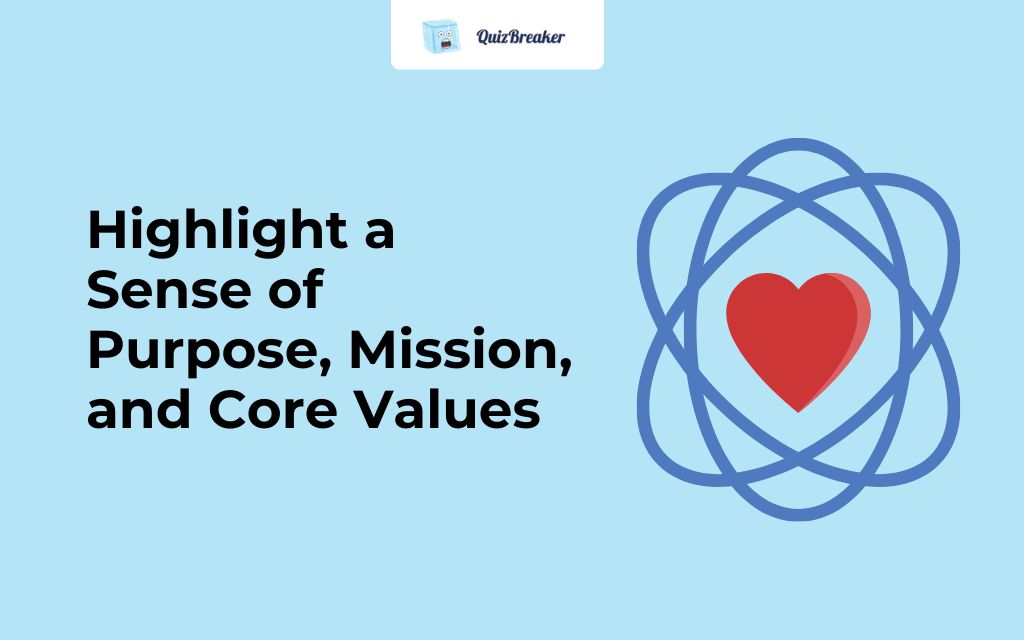
This is probably one of the most important employee engagement programs out there. After all, how can you expect to build a welcoming company culture, observe higher levels of employee satisfaction, and see your workforce more motivated than ever, if they don’t:
-
have a sense of purpose?
-
understand the company’s mission?
-
portray its values?
However, to instill such qualities and deeper understanding in your workers, you need to make sure you’re the one who fully comprehends them first. This means being aware of what each of these qualities stands for, so let’s briefly go over each.
Purpose
A purpose refers to the reason why a company exists in the first place. Purpose-driven companies are devoted to working toward great things which transcend the need for just high revenue and shareholder value.
Moreover, purpose-driven organizations seek to approach their work in a much more sustainable and ethical manner. All in all, they’re committed to the greater good.
Knowing all this, would you say your company is purpose-driven? If yes, what’s its main purpose? And how can you explain this to your employees?
Mission
Mission is very closely connected to the concept of purpose. In fact, many seem to use them interchangeably. However, we believe the main difference between the two lies in the following: the mission tends to focus on what the company is here to accomplish.
How would you describe your company’s mission? And how can this help engage your workers more? Also, what type of role do you play as an employer?
Values
Values usually refer to the beliefs an organization has, as well as the behavior it tends to adopt. Values matter because they’re the ones who set the overall expectations when it comes to how workers do their job, and how they communicate with clients, partners, managers, as well as their peers. What’s more, values tend to express what’s important to the company and help employers such as yourself make better decisions.
The notion of values is also connected to the principles the company and its workers have when it comes to doing business.
Finally, what values would you say your company demonstrates to the industry it belongs to? Are there any values you’d want to see change? If yes, which ones?
Something to reflect upon when applying this employee engagement program:
-
ensure your company’s senior leaders understand how these qualities represent part of the employee engagement programs your company has picked, and how defining them can bring about higher engagement levels;
-
make sure the rest of your workers understand your company’s purpose, mission, and values;
analyze whether your business is more purpose-driven or mission-driven;
-
see to it that your employees understand how purpose, values, and mission are connected to your company’s success;
-
apply all three in a practical way, as theorizing about them won’t bring the employee engagement levels you wish to see.
Case Study
Yes, there are case studies focusing on corporate purpose, mission, and values. And we’ve chosen one to share with you.
In essence, it’s all about how employers choose to make their purpose clear and known to their workers. That said, they do need to ensure the company itself reflects that same broader purpose as well. This is so because the concept of purpose doesn’t quite have meaning on its own. And this is what the study suggests: it’s about finding ways to expose employees to the purpose as well as raise awareness about it - that’s why makes workers be committed and interested in what they do.
At least this is what a study by Deloitte shows. And this isn’t everything. Apparently, a company’s purpose and mission have an impact on corporate confidence, too. Here are some stats from the study which support those claims:
-
47% of executives strongly agree that they can identify with their company's purpose, compared to only 30% of workers;
-
44% of executives claim that leaders are the ones who set an example of living that company's purpose. Just 25% of employees agree with this;
-
41% of executives say a company's purpose plays a big role in important corporate decisions, compared to 28% of workers;
-
38% of leaders claim their company's purpose is clearly and openly communicated, compared to 31% of employees.
All in all, instilling in your employees a sense of purpose, mission, and vision isn’t an overnight thing. It’s slowly built, but when it’s created with patience and commitment, it allows employers to reap its benefits.
5. Improve the Working Conditions in Your Company
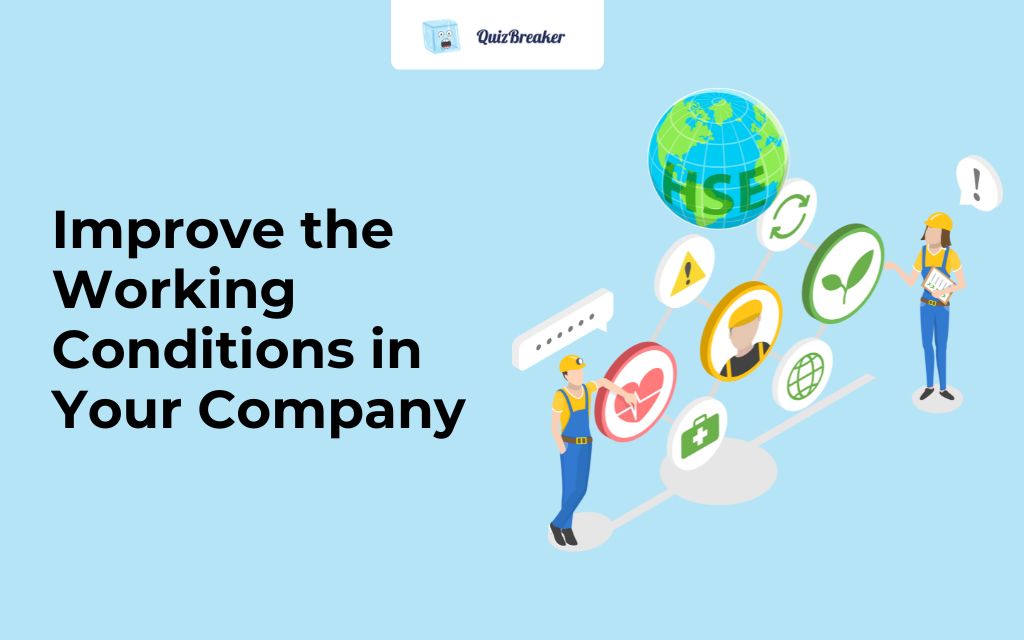
While it’s perfectly normal for employers to have high-performance expectations from their workers, they also need to provide their employees with the necessary conditions to do their best. A place where they feel good both physically and mentally. And we’re not just talking about redecorating your office space, but supporting your employees in any way you can as well.
If this employee engagement program is something you resonate with, below we share some useful suggestions to help you include it in your business practice:
-
build supportive teams;
-
allow employees to learn from their mistakes by owning up to them;
-
encourage a healthy competition;
-
don’t accept toxic behaviors;
-
make your office a nice place to be at, and so on.
Case Study
One excellent way in which you can support your employees is by encouraging them to focus on the good that’s already present in their lives. And one of the ways you can do so is by encouraging gratitude.
When a consultant named Stephanie Pollack had the chance to teach a group of reluctant workers about the benefits of gratitude and recognizing the good things in their lives, that’s when everything changed for them.
During a three-day retreat, Pollack taught a group of somewhat reluctant employees about the benefits of gratitude. She basically explained what it means to acknowledge the good things in one’s life. And then, “something shifted”, as the article suggests.
After one of the workers wrote a genuine note on a so-called “appreciation wall”, everyone decided to participate in this “gratitude experiment”. What was remarkable was the fact that toward the end of the retreat, many of the closed-off employees started to open up about their emotions and experiences.
Stephanie Pollack stated that they have “walked in with a lot of tension and frustration,” and although they probably didn’t walk away “with none, [..] there was a willingness on everyone’s part to move forward together in a different way”.
This attitude of gratitude isn’t anything new. And it shouldn’t come as a surprise considering all the benefits that come with it, such as less stress, better overall health, higher satisfaction levels, better interpersonal relationships, a greater sense of unity, more positive feelings, and so on.
Building a culture of gratitude in your company may take some time, but eventually, it can transform your organization for the better. Namely, this will not only lead to employees appreciating their jobs, coworkers, and positions more, but it will help them appreciate themselves on a whole new level, too.
You don’t need any complex or formal plan to apply this “attitude of gratitude” plan in your organization. All it takes is commitment, awareness, and ensuring employees are willing to go along with it. And if they knew the positive results others have obtained with this kind of approach, we’re more than sure they’ll be up for it.
6. Open Consistent Lines of Communication
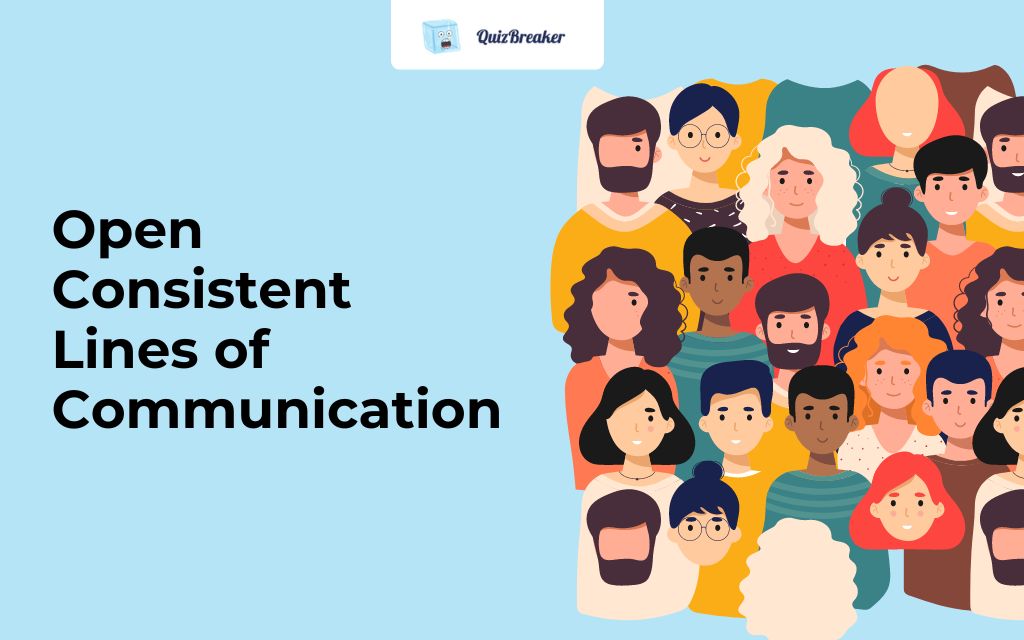
Many workers (especially new employees) are quite reluctant to share their true thoughts, opinions, and concerns in front of their managers or employers, and the reasons for this vary. Some may believe their managers aren’t really bothered with their opinions and perspectives, while others have tried but there was no action taken by their supervisor.
If you think that you’ve done everything to achieve open communication in your company, we applaud you. But if you think there’s more work to be done when it comes to showing your employees that you value interaction and want everyone to feel comfortable with expressing themselves freely, take a look at the following practical suggestions.
Ways To Encourage Honest Communication:
Don’t judge and “agree to disagree”
Embracing the different opinions that exist between you and your workers’ reasoning has its benefits.
Being exposed to an opinion you disapprove of, or simply dislike, forces you to think critically and understand where this person is coming from. Basically, instead of judging an employee because of something they said/did in a way you don’t think it’s right, ask yourself the following questions:
-
What is this behavior showing me about my company?
-
Why is this bothering me so much?
-
How can I let them know I disagree with the suggestion without sounding judgemental?
-
What does this situation teach me?
-
Am I really trying to understand the reasoning behind their decisions?
On the whole, creating a company culture that honors differences is a great employee engagement strategy you can consider. Disagreements and in-depth discussions help employees be creative and solve their issues in a much more innovative way.
Practice reflective listening
Reflective listening requires you not only to listen and understand the message that’s being conveyed - it’s also about letting the other person know they’ve been both heard and understood correctly. It’s about engaging in attentive and meaningful communication.
There are many ways to show your employees you’re listening attentively. For instance, you can repeat or re-state what an employee had said when you reply and express your own opinion. You can even let them know you’re aware of their body language, tone, and overall facial expressions. So, you can tell them “I can hear the excitement in your voice”, or “The worried look on your face says it all”, and so on.
Show respect to receive respect
Showing respect to your employees makes you open to receiving respect back. Respectful communication shouldn't be seen as some of the many employee engagement initiatives you can implement - it’s supposed to be seen as common sense.
You’ve probably heard the phrase “respect is earned, not given”, and there’s definitely some truthfulness to it. So, how can you earn your employees’ respect? Especially in a communication context?
Well, for starters, it’s important to let your workers know they have your full attention (this is sort of connected to the previous section). It’s about showing them you’re truly interested in what they have to say.
Making eye contact, not getting distracted by your phone, not interrupting them while they’re talking or treating them impolitely just because they said something you don’t quite want to hear are just some ways to do this.
All in all, showing respect to your employees means transcending any common employee engagement strategy. It’s something that should come from within. And when you’re able to show such respect, your workers should be able to reciprocate it.
Allow non-professional communication
As an employer, you can’t just communicate with your workers when you need them to:
-
submit a project proposal;
-
contact a client;
-
give feedback;
-
answer a question;
-
send a report;
-
help new employees;
-
take part in an employee engagement survey;
-
give a presentation about the latest idea they’ve been working on, and so on.
Although you’re supposed to have a professional relationship with your employees and communicate about business matters, nothing prevents you from sending them a birthday message, congratulating them on becoming parents, asking how their weekend went, or simply greeting them in the morning when you see them.
Unfortunately, a lot of employers get so tangled up in all the formal employee engagement programs they want to incorporate into the company culture that they forget about the beauty of a somewhat informal approach. This type of employee engagement strategy brings about employee satisfaction, but even more importantly, it helps create a comfortable environment in which workers should feel much more confident to be open with you (and their peers as well).
Acknowledge your employees’ views
You can’t have open discussions with your employees if you don’t recognize their viewpoints. This means recognizing different ideas, being open to suggestions that may be quite different from yours, and debating over issues for much longer than you may have anticipated.
That said, employees know you have the final word as an employer and that you probably won’t go ahead with an idea you disagree with. And this is fine because acknowledging your workers’ ideas doesn’t always equal accepting and implementing them right away.
It’s more about respecting their views and allowing them to come forward with their suggestions. This will allow you to also gain insights into what’s going on in your organization, as workers will feel much more comfortable sharing stuff with you in general.
Go to your employees for input
Acknowledging your employees’ views when they come to you matters, but sometimes what’s also important is you going directly to them. In other words, it’s about you asking for their input and allowing them to come forward with their own opinions.
This is not only a good employee engagement strategy, but it’s an initiative that brings about higher levels of job satisfaction within your workforce.
Finally, when it comes to this employee engagement program (honest and transparent communication), it’s worth knowing that all these employee engagement initiatives are complementary. They’re very similar in nature and they have one main goal - to help you and your employees establish the type of communication that will enable your business to flourish.
Case Study
The research study we chose for this section shows us just how important communication is in every corporate context. And while this specific context focuses on a single industry, we dare conclude its implications are widely relevant.
The main goal of this study is to analyze the deeper communication between the employer and their employees, and how it affects engagement levels. To do so, two objectives were taken into account:
-
identifying how supervisor-employee communication affects engagement;
-
identifying any obstacles to supervisor-employee communication.
Here are the main findings of the study: first of all, it was confirmed that supervisor-employee communication has a huge impact on engagement. Next, it was proven that this impact was very similar to what previous literature and research already suggested - the theoretical framework outlined by experts, researchers, and scientists “works” in practice and isn’t obsolete.
We’re talking about claims such as:
-
supervisors need to repeat the same things a couple of times via multiple communication platforms;
-
motivation is a natural response to situations employees find themselves in, and shouting at workers won’t make them work harder;
-
all workers have two main relationships at work - one with their immediate supervisor and another one with the organization as a whole.
You can read more about the claims by checking out the whole study.
It’s worth adding that the findings also supported the general definition of engagement as a shared responsibility between supervisors and employees.
All in all, this case study shows that establishing communication with your employees:
-
is never a waste of time;
-
always comes with a plethora of benefits;
-
and can do wonders for the employee engagement levels in your company.
7. Have Fun!

Everyone wishes to be a part of a company with joyful and positive workers. However, if workers aren’t encouraged to have fun, how can you expect them to be joyful?
Happy workers are much more motivated, productive, and engaged than their unsatisfied peers. And happiness goes hand in hand with having fun.
But there’s a time and place for everything. Having fun doesn’t mean neglecting your tasks, ignoring clients, and missing deadlines. Learning how to balance the “fun” bit and the “working” one is key here.
Also, when we talk about having fun and being happy, we don’t suggest that employees should be smiling 24/7 and walking around the office with fake smile on their faces. What we’re saying is that workers should get the chance to do fun stuff to uplift their mood, change the scenery, and refresh their thoughts. By doing so, they’ll be much more productive when it comes to handling their everyday work tasks.
Of course, sometimes employees may be going through some difficulties (perhaps a divorce, mourning the loss of a family member, dealing with a sick child, to name a few), or they may not be up for some fun events. In these moments, you need to let them know you’re here for them no matter what. When the time is right, they can start socializing and have fun like they used to.
All in all, although this is one of those employee engagement programs that may require adequate planning and organization, don’t forget they’re also meant to be spontaneous and, well.. fun, so make sure you and your team members enjoy them.
Suggestions for Having Fun in the Office
-
Celebrate employees’ birthdays and personal milestones;
-
Have lunch together;
-
Organize a different virtual team-building event](https://www.quizbreaker.com/virtual-team-building-activities) for remote employees and freelancers who do remote work for your company;
-
Tell jokes (when it’s appropriate to do so);
-
Play online team building activities in the office;
-
Encourage a positive sense of humor (but never support mocking someone or any sort of offensive jokes);
-
Allow your employees to bring their pets to the office once a month (of course, this may be a tricky suggestion, as it all depends on your office’s conditions and whether all employees agree with this - for instance, if you have an employee who’s allergic to cats and the peer who sits across them wishes to bring their cat, it goes without saying that this isn’t an acceptable scenario);
-
Organize an after-work party on Fridays or have a happy hour at the office (and yes, we suggest preparing your own cocktails);
-
Engage in sports activities;
-
Go bowling every once in a while;
-
Listen to good music in the office (that said, this may be challenging, as most workers may have their own understanding of what “good music” means, probably because they have different music tastes);
-
Have a WhatsApp group where you can share memes, fun information, or simply connect;
-
Go on a scavenger hunt;
-
Organize a karaoke event every now and then.
Finally, you don’t need to be the one who always plans the fun games ahead or worry whether your employees will like them. Feel free to ask them what they resonate with and whether some of them would like to help you organize some upcoming fun event.
Case Study
A study named Finding Fun in Work: The Effect of Workplace Fun on Taking Charge and Job Engagement analyzes fun as a positive phenomenon in the workplace. More specifically, it explores the ways the concept of fun contributes to the workplace.
On the whole, fun is present in every place in a wide range of ways, ranging from social events, public celebrations, and milestones, all the way to jokes, games, and office humor.
The study has five hypotheses as a starting point, including:
-
H1: A positive relation exists between fun activities and taking charge.
-
H2: A positive relation exists between manager support for fun and taking charge.
-
H3: A positive relation exists between coworker socialization and taking charge.
-
H4: A positive relation exists between taking charge and job engagement
-
H5: Taking charge mediates the relationship between (i) fun activities, (ii) coworker socialization (iii) management support for fun and job engagement.
Unsurprisingly, the study’s results show that having fun in the workplace affects workers in a positive way. It improves job satisfaction levels, commitment, energy, productivity, and creativity, while reducing anxiety, turnover, burnout, and absenteeism.
In general, the study showed that workplace fun is very closely related to the engagement levels in the company.
All in all, the overall recommendation is that employers and managers should encourage humor in the office and allow for fun activities to take place. Both formal ways (competitions, social events, public celebrations) and informal ones (telling jokes, socializing during coffee breaks, and so on) should be taken into account.
And with this, we conclude the best employee engagement programs. If there are some questions left unanswered, take a look at our FAQ section.
Frequently Asked Questions
Why is employee engagement of importance?
Employee engagement is important because it touches upon each area of your business. Employee motivation? You can’t have it without engagement. Employee retention? Can’t have it without employee engagement. Better work culture? Unlikely if your workers aren’t engaged. Higher revenue? It’s a no if your employees don’t put in the work.
Put simply, the employee engagement levels in your company determine how successful your business will be. As a Forbes article explains, employee engagement is, [...] “a symptom of success. Employees who are succeeding and feeling good about their contributions to your company are naturally more likely to:
-
be proud to work for your company
-
be happy to come to work each day
-
feel valued”.
In general, a lot can be written about the importance of employee engagement and all its benefits, but here are the most common advantages companies with highly engaged individuals can enjoy:
-
creative ideas;
-
better relationships;
-
better customer care;
-
higher impact in the industry (leading by example);
-
increased company profits;
-
a healthy work environment;
-
enhanced company culture;
-
reduced staff turnover;
-
better performance and productivity results;
-
less procrastination;
-
more initiatives;
-
effective work schedule, and so on.
How do I choose the right employee engagement programs?
This seems like a very simple question - yet it’s quite difficult to give a comprehensive answer. And that’s probably because when it comes to picking the right employee engagement programs, there’s not a standardized checklist all employers can use to see whether they're on the right track.
The good news is that you’re the one who knows best if you’ve chosen the right employee engagement program(s) or not.
With that said, there are some guidelines and criteria you can take into account when deciding on which employee engagement programs you want to incorporate into your organization. For instance, if you’re looking for a free employee engagement program at the moment, you’ll probably skip our suggestions about having fun which include escape rooms, murder mystery games, and so on. You also won’t prioritize coming up with an extensive (and expensive!) wellness program.
You might decide to opt for something else, such as ensuring honest and transparent communication or showing appreciation.
Also, if you’re already using some employee engagement programs, we recommend observing how your workers react to them. Does it seem like they approve of those employee engagement programs? Are there higher levels of engagement within the workforce?
Reflecting on questions such as these and considering your overall approach as an employer will help you determine which employee recognition program might work well for your organization.
How can I tell if I’m dealing with engaged or disengaged employees?
There isn’t a single correct test that determines whether you’re dealing with an engaged or a disengaged employee. It’s a whole selection of behaviors, decisions, and appearances which helps employees determine what group their employees fall into.
And here are some guidelines to help you do so.
Engaged employees
Engaged employees are those who adopt the company's mission, values, vision, and overall purpose. They contribute to it passionately, have good relationships with their peers, don’t have any trouble taking initiative, and come up with creative solutions most of the time.
They’re also very enthusiastic about what they do and are absolutely certain they’re a huge asset to the organization. Moreover, engaged workers have no problem helping new hires or peers who might have come across a problem. They welcome healthy competition a lot more than other workers.
They can do things on their own and also work in teams. They’re flexible and capable of adjusting to a wide range of situations. Engaged workers seem to be pushing the company forward, and are key when it comes to securing returning clients and great customer service.
You can also tell if your employees are engaged when they're not leaving your company. So, you should start measuring your employee turnover rate regularly. Here's a free calculator tool that can help you measure and improve your turnover rate.
All in all, engaged employees are highly trustworthy and know what they’re doing and why they’re here to do it.
Disengaged employees
Disengaged employees display very little to no initiative when it comes to their performance. They aren’t really concerned with the clients the company handles and don’t really seem to care whether a client returns or not.
If they end up in a group project, they don’t seem to show any leadership skills. It’s almost like they’re passive participants, waiting on others to do their part.
Disengaged workers don’t seem to want to improve their skills or qualifications. They aren’t bothered with career progress (although they probably would like to receive a higher salary if something like that was on the table, but without the extra responsibilities that come with it).
What’s more, such workers are more than likely to play games at work, spend a lot of time on their social media channels, talk on the phone, take frequent breaks, and basically find a way to do anything but the actual work that needs to be done.
Disengaged workers behave as though they have no reason to work harder. There’s a lack of motivation and they tend to associate working with boredom. Also, they might behave negatively toward their peers (and perhaps even toward their superiors as well).
Final Words
All in all, there’s a plethora of employee engagement programs you can choose from. We hope the ones we’ve outlined resonate with you and where your business is at the moment. Above all, we hope they resonate with your employees, as that’s who they’re meant to help the most.
For more articles on employee engagement, check out these ones next:



